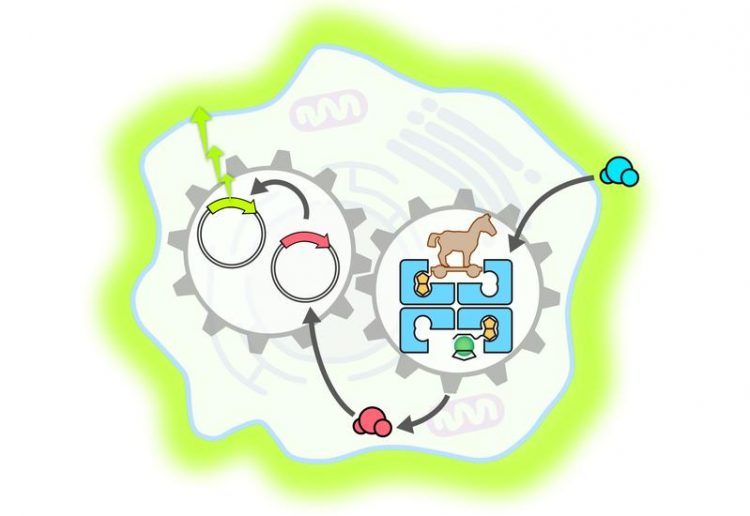Designer cells: artificial enzyme can activate a gene switch

Artificial metalloenzyme penetrates a mammalian cell, where it accelerates the release of a hormone. This activates a gene switch which then leads to the production of a fluorescent indicator protein University of Basel, Yasunori Okamoto
Nature relies on enzymes to accelerate energy-intensive biochemical reactions that are necessary for the preservation of life. However, natural enzymes are not all equally suited for all reaction types. Artificially created catalysts are much more versatile, as they can promote many more chemical synthesis processes.
There is therefore great potential in introducing artificial catalysts into living cells and organs in order to modify cell functions on a genetic level or to create a drug from a harmless precursor in the cell itself. However, such catalysts often work only under strictly controlled conditions that are almost impossible to achieve in living cells.
Cascade of artificial components
To overcome this restriction, researchers from the Universities of Basel (Professor Thomas Ward) and Geneva (Professor Stefan Matile) and from ETH Zurich (Professor Martin Fussenegger) developed a small-molecule catalyst that can control a gene switch. If this switch is activated, the desired cell function is triggered.
For the current study, the researchers produced a metalloenzyme – a biocompatible protein in which a catalytically active metal fragment (in this case ruthenium) is incorporated. With this method, they succeeded for the first time in developing an artificial metalloenzyme that was able to penetrate a mammalian cell.
Once in the cell, the metalloenzyme – like a Trojan horse – deployed its catalytic function and accelerated the production of a particular thyroid hormone. This hormone then activated a synthetic gene switch that led to the creation of a fluorescent protein called luciferase.
A new kind of chemistry in living organisms
The study, published in Nature Communications, proves the feasibility of an innovative approach that targets the development of cell functions and aims to complement traditional biochemical processes. The work is a good example of the opportunities offered by the combination of synthetic biology and organometallic chemistry for the control of cell functions in living organisms.
https://www.unibas.ch/en/News-Events/News/Uni-Research/Artificial-enzyme-can-act…
Media Contact
All latest news from the category: Life Sciences and Chemistry
Articles and reports from the Life Sciences and chemistry area deal with applied and basic research into modern biology, chemistry and human medicine.
Valuable information can be found on a range of life sciences fields including bacteriology, biochemistry, bionics, bioinformatics, biophysics, biotechnology, genetics, geobotany, human biology, marine biology, microbiology, molecular biology, cellular biology, zoology, bioinorganic chemistry, microchemistry and environmental chemistry.
Newest articles

Silicon Carbide Innovation Alliance to drive industrial-scale semiconductor work
Known for its ability to withstand extreme environments and high voltages, silicon carbide (SiC) is a semiconducting material made up of silicon and carbon atoms arranged into crystals that is…

New SPECT/CT technique shows impressive biomarker identification
…offers increased access for prostate cancer patients. A novel SPECT/CT acquisition method can accurately detect radiopharmaceutical biodistribution in a convenient manner for prostate cancer patients, opening the door for more…

How 3D printers can give robots a soft touch
Soft skin coverings and touch sensors have emerged as a promising feature for robots that are both safer and more intuitive for human interaction, but they are expensive and difficult…





















